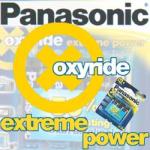
One of the key problems facing consumers is that portable electronic devices are getting more power hungry with each new generation, but those single-use alkaline batteries that power them haven't really improved much over the last decade. Perhaps 10 or 20 years from now, it will seem silly that we had to tote around two or three spare sets just to make sure that we could always use our portable device whenever we wanted to. Or, has that time come already in the form of Oxyride?
While attending this year's Consumer Electronics Show in Las Vegas, I was approached by Lindsay Singler, a PR representative for Panasonic, who surprised me by not wanting to show me the latest and greatest digital camera or flat panel television. Instead, she wanted to show me Oxyride, their latest revolution in battery power for high drain devices like digital cameras and MP3 players.
As a journalist in the electronics biz, there are two lessons that you learn quickly. Lesson number one is that every manufacturer has something "new and improved" that is going to change how we use electronics. Lesson number two is that most of these claims are grossly over exaggerated. Though their display was unquestionably hard to argue with, the skeptic in me couldn't help but remember every time a big name battery company has cried revolution, but only provided a marginal performance improvement. Maybe I was just convinced that the promise of better battery life equates to five more minutes of playtime on my MP3 player, or seven more pictures from my digital camera.
When I asked how Oxyride was better, I was told, "Oxyride provides two to three times the performance over top-performing name-brand alkaline batteries in the market." Of course, my skeptic brain translated this as, "Oxyride will last a little bit longer than Energizer and Duracell." Since I'm as much a cheapskate as I am a skeptic, it would only seem obvious that my next question would be to ask how much more two to three times the performance would cost over regular alkaline batteries (I'm sure not going to drop 12 bucks for two AAs). It was the answer to this question that finally perked my interest. "Nothing." she said. "Oxyride batteries are the same price as a quality name-brand alkaline." For a guy who's mission is to help people get more from their gear, anything that supposedly provides that much of a performance gain for no increase in cost is something I had to investigate. My main question... Was it true?
About Oxyride
For the record, Oxyride is not an enhanced formula of alkaline. In fact, the only similarity is that they're both dry-cell batteries, and both come in the standard cylindrical AA and AAA shape. Rather than try to continue to improve a technology that is already 20 years past its prime, Panasonic chose to rethink the battery, and just as importantly, how they're made.
Oxyride, the result of eight years of battery research, is the consumer friendly name for a newly developed material called Oxy Nickel Hydroxide, which has a higher initial voltage than alkaline. However, it's just not new materials that make Oxyride one powerful little package. Their new vacuum pouring manufacturing process allows them to pack more electrolytes into the battery. With these two innovations combined, Oxyride can keep high-drain electronic devices running for much longer than a traditional alkaline battery.
Of course, it's hard to take any manufacturer's word when it comes to how revolutionary one of their poducts really is. So, it was time to put Oxyride to the test.
The Test
Panasonic says that Oxyride is designed to outperform other batteries in high drain electronic devices. So, to find out how much better Oxyride really was, I decided to grab the most power hungry device in my arsenal. Say hello to the Kodak EasyShare CX4200:
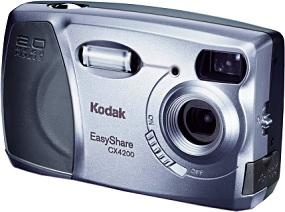
It's a slightly older, inexpensive consumer digital camera that chomps through AA batteries like Homer Simpson at an all-you-can-eat buffet.
At a local retailer, a set of four Oxyride batteries costs $4.99. I figured the main challenger should be something that cost around the same price. It turned out that a set of 4 Energizer Max batteries cost $4.49 at the same retailer. I also thought it would be interesting to put it against an inexpensive set, and luck would have it that Panasonic's own Alkaline plus was on sale for $1.99. Why not find out how Panasonic's Oxyride stacks up against their own alkaline offering?
Our Contenders
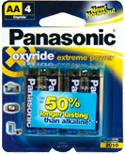
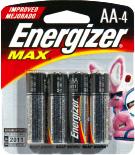
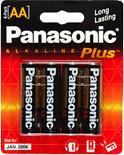
The test was relatively simple. I started by checking the initial voltage of each set with a voltmeter, and recording the results. Then, I would load a set of batteries into the power hungry Kodak CX4200, and keep snapping photos. To keep the test fair, all images were taken with the flash, and at the same resolution. Throughout the photo snapping process, I made a note when the battery warning indicator came on. The test was over when the camera turned itself off.
The Test Results
| Panasonic Plus | Energizer Max | Panasonic Oxyride | |
| Initial Voltage | 1.61 Volts | 1.63 Volts | 1.73 Volts |
| Warning Light | 78 pictures | 72 pictures | 371 pictures |
| Final Voltage | 1.40 Volts | 1.40 Volts | 1.43 Volts |
| Total Pictures Taken | 116 pictures | 102 pictures | 537 pictures |
| Cost Per 100 Pictures | $.86 | $2.20 | $.46 |
I'll admit, I initially thought Panasonic was exaggerating about how much better their Oxyride batteries really were, but five times the performance over Energizer Max says it all. I wasn't only wrong... I was way wrong. Five times seemed a bit high, so to be fair to Energizer, I repeated the test with a different batch. Sure enough, the results were similar (the best scores are reported). I can only assume that five times the performance is a bit out of the norm, but it sure makes their claim of two to three times totally believable.
It's the higher voltage that really makes Oxyride shine. Most alkaline batteries start with an initial voltage between 1.5 and 1.6 volts. As the battery is drained, the voltage drops. Since Oxyride starts at around 1.7 volts, it can maintain a higher voltage for a longer period of time. This was evident in the Kodak CX4200, which apparently would refuse to operate once the battery approached 1.4 volts.
Operating at a higher voltage could have its benefits for other things as well. "If you put Oxyride into a remote control toy car, the car will actually drive faster," says Brian Kimberlin, Director of the North American Battery Group for Panasonic. "If you put [Oxyride] into a high performance LED flashlight, the light is actually brighter. These are all benefits that Oxyride brings; not only longer lasting, but also more power."
While the slightly higher voltage is pretty safe for most electronic and motorized devices, it is not something you'd want to put into a regular bulb based flashlight, or anything similar. At 1.73 volts starting, Oxyride is pushing the outer limits of what I would consider safe for devices designed to use 1.5-volt batteries. Hopefully, additional performance can be found in Oxyride without having to further increase voltage.
Conclusion
It looks like slow and steady wins the race for every rabbit that isn't pink and pounding a big drum. Not only did Oxyride absolutely destroy Energizer's Max product, but to add insult to injury, Panasonic also edged out a win over Energizer with their significantly lower priced alkaline. Even if the results were flipped, I'd still call it a win since Panasonic's Alkaline Plus is significantly cheaper than Energizer Max.
One undeniable fact remains; Panasonic has hit a grand slam with Oxyride. It actually provides significant performance improvements over regular alkaline batteries, and doesn't cost you any more than the premium alkaline battery that is powering your digital still camera right now. Even if you don't believe it yourself, try them once. I guarantee you won't ever use anything else in your high-drain electronics again. It's a no-brainer.
Listen to our interview with Panasonic's Brian Kimberlin in the
TechLore PodCapsule #2 - 'Empowering' Your Portables
Oxyride and Extreme Power are registered trademarks of Panasonic.




